Welcome to my Mangools SEO review.
In this review, you will learn what Mangools is, and how it can help you grow your online business.
We’ll cover the pros and cons. I cover the good stuff, but also reveal both the bad stuff as well.
You’ll also learn about one specific tool within Mangools that I feel is a waste of time using. And four other tools that can yield great results.
Sound good? Let’s get started:
Note: Want to skip the review and try Mangools for yourself? Click here to start your free trial.
What is Mangools SEO exactly?
Mangools is an SEO software that market themselves as a cheaper alternative to Ahrefs and SEMrush.
Mangools is a toolset that consist of 5 apps:
- KWFinder
- SERPChecker
- SERPWatcher
- LinkMiner
- SiteProfiler
After you’ve created an account, you’ll be able to log into your dashboard where you’ll see all 5 apps waiting to be used, along with usage limits for each tool based on your chosen subscription.
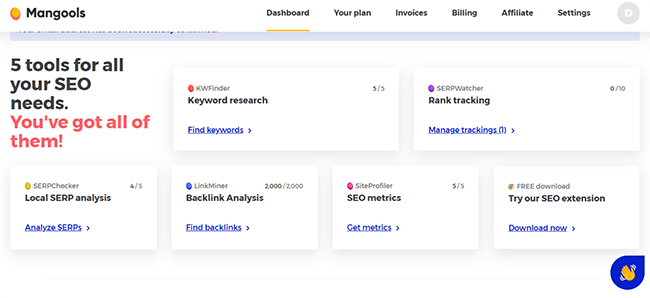
Note: While we use Mangools at Startup Bonsai, I started a free trial so I could go through the toolset just as a new customer like yourself would.
How to use Mangools SEO (all 5 tools explained)
Read this next section carefully.
It’s because you’ll learn how to use Mangools SEO-toolset to gain maximum value out of your subscription.
Also, since the tool consists of 5 different apps, and because I want my Mangools review to be actionable, and not some ungodly mess, I’ll cover the usage of each separately.
Catch your breath, prepared to be blown away with the sea of usefulness below, and let’s go!
#1- KWFinder
KWFinder is a keyword research tool and is the most well-known Mangools app. In fact, most marketers when they hear “Mangools”, they think of KWFinder and are often surprised that there are 4 more apps available.
I know that was the case with me.
Here’s how to use this keyword research tool:
First, log into KWFinder and enter in your target keyword, along with search location and language.
Our example keyword is “landing page builders”:
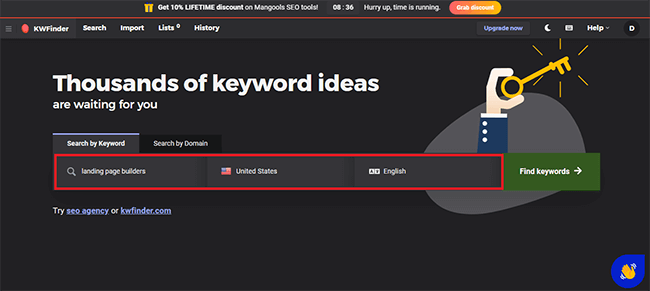
As your keyword report loads onto the screen, the first thing you’ll notice is that KWFinder’s reporting dashboard is really intuitive.
On the left KWFinder spits out a bunch of related keywords to you target phrase + important metrics for each (search volume, keyword difficulty, trends graph, PPC competition and CPC).
Right above the keyword list you’ll notice a bar where you have the option to toggle Autocomplete mode and Questions mode.
In the former, KWFinder will scrape Google autosuggest terms related to your target query.
In the latter, KWFinder will show you all keywords that contain your target term AND are also phrased as questions.
Finally you can easily save the keywords you like by checking the box in front of each and adding it to a keyword list.
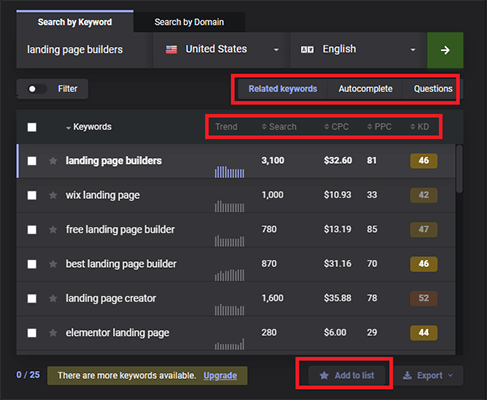
On the right, your target keyphrase is singled out along with crucial info you need to have.
First, KWFinder gives you a numerical score while showing the competitiveness of your target keyphrase.
Next, you see the trends graph which shows you whether your target keyword is growing or waning in popularity.
This is crucial info to have so you don’t end up targeting a phrase that no one searches for anymore.
Below the trends report you can see the SERPs overview and sites ranking in Google.
You can also see some crucial URL-specific metrics you need to know about if you are to compete in those SERPS.
The metrics are:
- DA — A ranking score by Moz that aims to predict link-based authority of the entire domain.
- PA — A ranking score by Moz that tries to predict link-based authority of that particular page.
- CF — Citation Flow shows the “influence” of ranking URL based on the number of links hitting that page.
- TF — Trust Flow score shows the strength of the URL based on the quality of links hitting that page.
- EV — External Links report you the number of external links hitting the page. By hovering over the number you can see link profile breakdown by number of links, number of unique referring domains, number of referring ip’s and subnets.
- FB — Number of Facebook shares provided by the Facebook API.
- LPS — Link Profile Strength score tells you the predicted strength of the URL. This is a Mangools custom metric.
- ESV — Estimated visits per month, based on search volume and position in the SERPS.
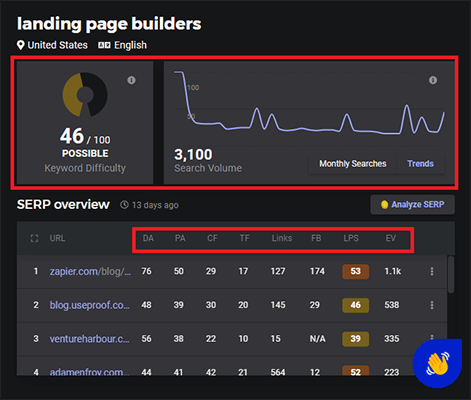
Pro tip: KWFinder lets you examine the whole domain to extract their lucrative keywords.
To use it, simply input a target domain in the search bar and the tool will show you all keywords that domain ranks for, which you can then proceed to filter based on ranking positions.
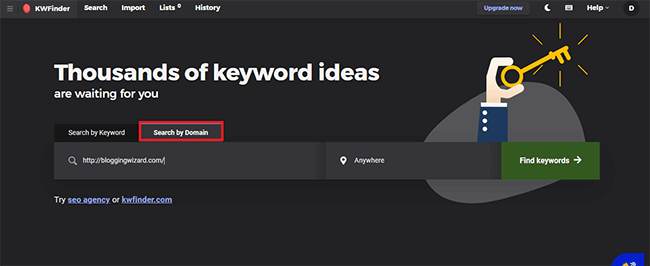
Overall, KWFinder is good value for your money, and it alone can help you get more traffic to your site and is enough to justify the $30 price tag.
But Mangools has 4 more apps to offer, so let’s keep going.
#2- SERPChecker
Next, we have SERPChecker.
This tool helps you get a better overview of the SERPs you’re about to enter with your page.
To use it, pick a target keyword and input it in the keyword field:
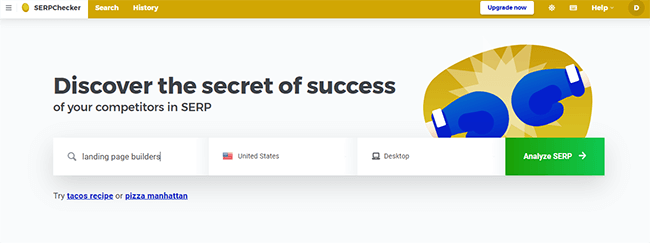
The results SERPChecker spits out are very helpful.
First, you see the keyword difficulty for the target keyword, plus the SERPS Features Impact.
What is it?
SERP Features Impact is a nifty feature that shows you how crowded the SERP is for your target term.
Google has become an answer engine, and some keywords are simply not worth targeting as Google is giving all the answers already.
SERP Features Impact feature shows you exactly what Google features are present on the page.
In the case of our example keyword, there are very few SERP features (Google Ads at the top and bottom + PAA boxes) and the keyword gets a green light.
Next, you can see all 10 ranking sites listed out, along with their metrics (DA, PA, CF, TF, LPS, AR, RD, RI…)
I won’t talk about those again because they’re the same metrics I covered in the KWFinder section above.
Finally, SERPChecker lets you compare your target URL with the current SERPS. That way you can clearly see the gap in authority between your page and those that currently rank.
Not a groundbreaking feature, but definitely makes your life easier as an SEO.
Overall, SERPChecker is a decent tool that can give you a lot of value if you decide to use it.
However, for the most part, I’d skip it as within the KWFinder dashboard I can already see the SERP overview and plot my ranking stratagem accordingly.
Pro tip: Oftentimes, Mangools and other SEO tools err and show you results that are not 1:1 match with the real SERPs.
That’s why it always pays to check on SERPs manually.
And to do it you’d normally need to have one tab open for SERPChecker, and another for Google, but with this tool you can get a live snapshot of the first page without leaving the dashboard.
Simply click on the “Snapshot” tab at the top

#3- SERPWatcher
SERPWatcher is Mangools rank tracker. You can use it to track your rankings and see the impact of your SEO efforts on your keyword rankings.
For example, you update the post today and predict you’ll get a rankings boost from a freshened up page that’s also better optimized and now has more high quality content.
But why predict when you can verify?
That’s what SERPWatcher is for.
To use it first you need to enter a set of keywords you wish to track. You can add them manually or from a spreadsheet.

And that’s it. Now it takes ~30m for SERPWatcher to populate the dashboard with your initial report.
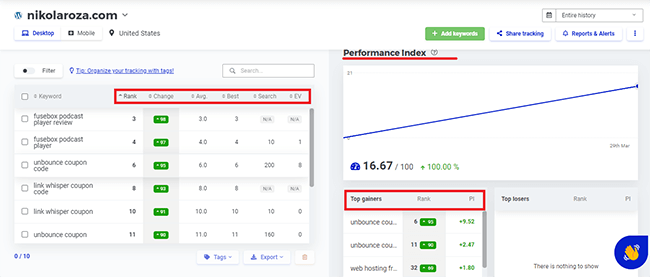
As you can see from the image above, SERPWatcher is a standard rank tracker, in line with pretty much any other tool on the market.
You can see your rank, estimated traffic, whether your keyword is trending up and down, search volume, etc.
On the right, you’ll notice the Performance Index, which gives you a generalized overview of how all your keyword rankings are performing.
Below you’ll observe your keywords listed out based on ranking gains they’ve had.
Very useful to weed out those where Google seems to really like you.
Match those terms to their host pages, go and update them by giving Google more of what they clearly love, and see your rankings soar even more.
#4- LinkMiner
LinkMiner is Mangools backlink analysis checker.
Unlike SEMrush, Moz and Ahrefs, which all boast their own link indices, LinkMiner doesn’t.
Instead, they get their data from Majestic SEO.
This is a good thing because Majestic SEO is a premium backlink checker that rivals Ahrefs in size of their index and speed of their crawler.
The data from LinkMiner is duplicated from Majestic which means you get a ton of value here.
You can use LinkMiner to check backlink profiles of both entire domains and individual pages.
Simply input your target URL and let it do its magic:
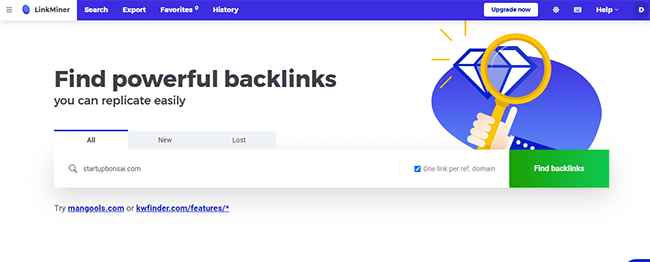
Once the results are live, you’ll be able to see all links pointing to your site, plus how LinkMiner/Majestic scores your website against their proprietary backlink metrics.
You’ll also be able to filter the results based on follow/nofollow link status and also new links won and lost.
Finally, each line you see comes with a set of Majestic metrics for evaluating its strength.
These are:
- Citation Flow (CF) — Score that predicts how influential a page is based on how many other pages link to it.
- Trust Flow (TF) -Score that predicts the power of the page based on the quality of the links pointing to it.
- EL — Shows you the total number of external links hitting that page;
- FB — Number of Facebook shares.
- AR — Alexa Rank.
- HREF — Show you the URL path.
- Anchor — Anchor text of the link.
- LP — Estimated link power of the link.
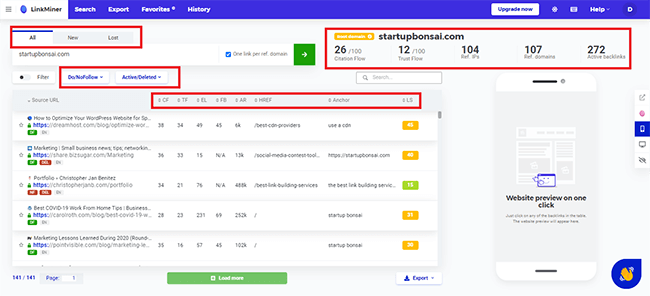
Overall, because LinkMiner is powered by Majestic backlink index, the reports are very valuable and LinkMiner can easily replace Ahrefs as your backlink tool of choice.
#5- SiteProfiler
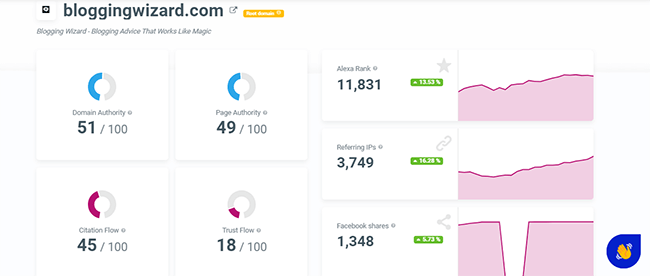
I mentioned in the intro that one of the Mangools apps is a waste of time and just a bloat to an otherwise excellent selection of SEO tools.
SiteProfiler is that app.
SiteProfile “profiles” a site by measuring its total backlink strength and popularity on Facebook.
And that’s it really.
Oh, you can also see the site’s top content which is somewhat useful as, if you’re aiming to steal content ideas from competitors, you’ll want to steal their best stuff that’s proven to work.
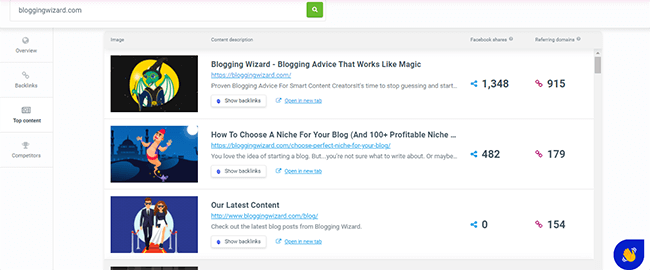
One nifty feature I love though is the top domains report. It shows you the best sites that link to your target domain, and these are ordered based on their Alexa rank.
This is very helpful info.
Why?
Because, if you happen to run into a site that boasts a really powerful link profile and has backlinks from some of the best websites in the world, it pays to take that domain and plug it into LinkMiner, and then delve deeper into their link profile.
If you can figure out how they’re getting those awesome links, it’ll be so worth it.
But overall, SiteProfiler seems like it has been added to make up numbers. That said, it has been a welcome addition for existing customers.
#6- Mangools Chrome Extension
Yes, similar to Moz, Ahrefs and SEMrush, Mangools also offer an extension for Chrome and Firefox browsers.
The difference is that you can use this extension without a premium Mangools account.
To use this extension, first install it from your Mangools dashboard.
Second, navigate to a page you want to inspect without bothering to go into LinkMiner, and then click on the orange ball (Mangools logo) button in the extension bar.
This will show you the site’s backlink prolife plus keywords they rank for and on-page SEO.
Overall, really good stuff for rapid site and page evaluation.
I like it!
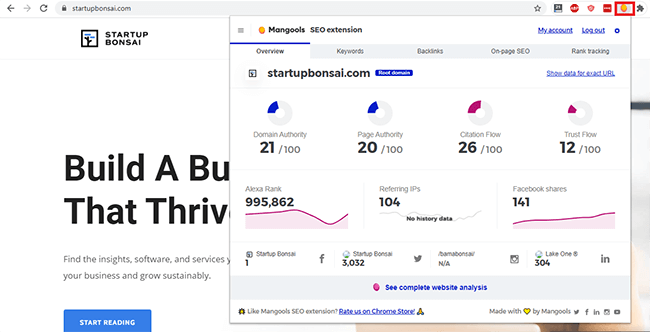
Mangools pricing — Is it value for money?
Mangools have 3 paid plans.
They are:
- Mangool Basic — $29.90/mo paid yearly; or $49/mo in monthly installments.
- Mangools Premium — $39.90/mo paid yearly; or $69/mo in monthly installments.
- Mangools Agency — $79.90/mo paid yearly; or $129/mo in monthly installments.
All plans come with the same set of features, and the only difference is usage quota allotted to each plan.
You can pay for Mangools in monthly installments or you can go for a yearly plan and get a 40% discount.
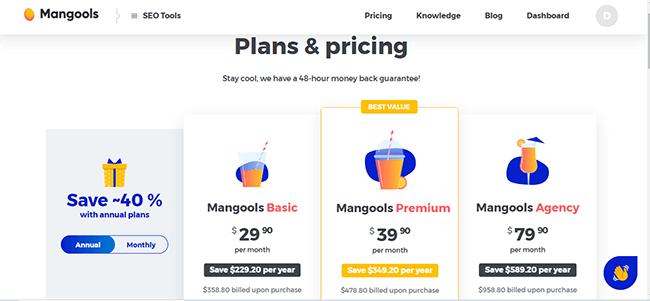
Mangools Basic is ideal for bloggers who’re looking for a budget tool to do some SEO for their small websites.
Mangools Premium is more for established bloggers who know the ins and outs of SEO, can’t afford Ahrefs and SEMrush, but still want to do holistic, wholesome SEO.
Mangools Agency is best suited for, you guessed it, big SEO agencies with dozens of clients.
Mangools pricing is super affordable compared to higher-end Ahrefs and SEMrush plans, and it gets the job done and clients are happy.
Mangools pros and cons
My Mangools review is overwhelmingly positive, and the reason behind it is dead simple.
Mangools is a quality product and is value for money.
However, it’s also flawed in some key areas and you’ll want to learn about it below.
Pros
- All-in-one SEO toolset — Mangools feels like a complete solution to all your SEO needs. You can literally get this tool and handle the SEO side of your business without difficulty.
- Affordable — The cheapest plan is $29.90 (paid yearly) and with it you get access to all 5 apps and decent usage quota. But even the most expensive plan is more than 3x cheaper than Ahrefs high tier plan.
- Superb UX — Mangools app and their dashboard are a pleasure to behold. Very simple, elegant and intuitive. Even a total noob can learn to get around the tool in 10m or less.
- Superb link index — Link building is crucial for SEO and with LinkMiner and its Majestic-powered index, you have the tool to get the job done successfully.
Cons
- Lack of integration — Mangools 5 apps are not integrated, so when using Mangools toolset you’re actually using 5 different tools at the time. This gets cumbersome and unwieldy fast.
- SiteProfiler — This tool gives you the data from LinkMiner, except presented in a slightly better format. In my opinion it’s an unnecessary addition to the core 4 tools.
- Free trial quota is severely limited — With Mangools 10-day free trial you can only track 10 keywords, do 5 keyword searches per day, profile 3 websites, and get 2000 backlink rows data. I guess that’s enough to get a taste, but if they decide to double, triple or quadruple that quota, you won’t find me complaining.
Verdict — Is Mangools worth it?
My Mangools review is done.
Is Mangools right for you? The answer depends on your needs.
If you are looking for an affordable SEO tool or you are looking for a tool that is particularly user friendly — Mangools could be perfect for you.
You can handle keyword research, investigate SERPs, track your rankings, and analyze competitor’s backlinks. It has a strong feature set and a superb user interface.
For the money, it is exceptionally good value and it is great for beginners.
Sure, it lacks some of the advanced features you’ll find in tools like SEMrush but it is also a heck of a lot cheaper. And it removes the problem of being overwhelmed by so many tools. Some of which, you may not use.
Ultimately, Mangools stands out as an affordable alternative to the likes of Ahrefs & SEMrush.
Now, I highly recommend clicking the link below and starting a free trial.
That way, you can get a feel for the platform and make sure it is the right one for your needs.
Немає коментарів:
Дописати коментар